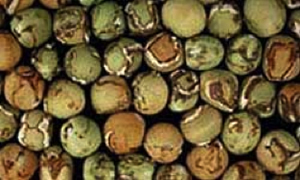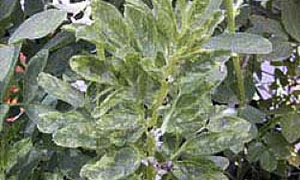Temperate pulse viruses: pea seed-borne mosaic virus
Pea seed-borne mosaic virus is distributed worldwide. It was first introduced into Australia in 1978 in seed imported from Sweden.

Its natural host range is limited to the Fabaceae family, and it infects pulse crops and pasture legumes. The virus may be symptomless, or show as mild mosaic symptoms on field peas and other legumes.
Early infections may cause considerable yield loses. PSbMV also affects seed quality by causing brown ring patterns and spots on the seeds of field pea, faba bean, lentil, chickpea, lathyrus and other legumes.
Seed transmission of this virus may be as high as 100 per cent in field peas, while reaching significant levels in other legumes. The virus is also transmitted mechanically and by aphids.
What to look for

PSbMV symptoms on plants are often difficult to identify under field conditions as the virus may be symptomless, or only show mild mosaic symptoms. However, pulse seed symptoms include brown rings or line patterns on the seed surface.
Symptoms of PSbMV on pulses are:
- Field peas develop various degrees of stunting, downward curling of leaflets as well as a transient clearing and swelling of leaf veins in most cultivars. Infected plants may also produce distorted flowers, which often give rise to small distorted pods. Ovule development in affected pods may be uneven, with only one or two seeds being produced. Seed coats may split as the seeds mature. The symptoms on seeds result in brown rings and tan spots.
- Faba beans develop a systemic dark and light-green leaf mottle, leaf margins become upright and the leaf blade is reduced in size. The seeds from infected plants show brown ring patterns and reduced size.
- Chickpeas develop yellowing on new shoots, mottling of leaves, downward curling of leaves and plant stunting.
- Lentils may show no symptoms or there may be chlorosis in new shoots, mottling on leaves, shoot tip necrosis and stunting of plants.

Disease cycle
Transmission
The virus is believed to have spread worldwide through the exchange of infected seed.
Seed transmission rates of up to 100 per cent in field peas and up to 44 per cent in lentils have been reported. In Victoria, PSbMV has been detected at low levels in commercial chickpea seedlots (0.4 per cent of seed) and at higher levels in field pea and lentil seedlots (greater than 2 per cent of seed).
In the USA, PSbMV infection has been reported in pea seedlots (3%) and in lentil seedlots (32 to 40 per cent). Research at the International Centre for Agriculture in the Dry Areas (ICARDA) found PSbMV was transmitted through lentil seeds at rates of up to 44 per cent.
PSbMV is also transmitted in a non-persistent manner by more than 20 aphid species, and by mechanical means.
The most efficient vector of PSbMV worldwide is the pea aphid (Acyrthosiphon pisum). Surveys of Victorian pulse crops have found cowpea aphid (Aphis craccivora), foxglove aphid (Aulacorthum solani), and green peach aphid (Myzus persicae) to be important vectors of the virus.

Host range
The natural host range of PSbMV is limited to the Fabaceae family.
The virus infects temperate pulses (chickpea, faba bean, field pea, lentil) other legumes (garden pea, narbon bean, lathyrus, vetch) and legume pastures.
A number of PSbMV pathotypes have been recognised by their ability to infect a number of pea differential genotypes.
Economic importance
PSbMV is of economic importance in field pea, faba bean and lathyrus mainly due to its effect on seed quality.
It was considered to be a minor disease because it was thought to only cause mild symptoms and minor yield loss. However, at ICARDA in Syria, glasshouse studies showed yield losses due to PSbMV in chickpea, faba bean, lentil and pea were 66 per cent, 41 per cent, 45 per cent and 49 per cent respectively (Makkouk et al., 1993).
In South Australia, glasshouse experiments showed that pathotypes P1 and P4 could reduce seed yield by 35 per cent and 82 per cent respectively (Ali and Randles 1998).
In New South Wales, DPI-Tamworth screening field pea germplasm in the field for resistance to PSbMV has shown that highly susceptible lines may be 100 per cent infected late in the season (Van Leur, unpublished).
Surveys of pulse crops over the last 10 years in south eastern Australia have shown that PSbMV is an important virus of field pea crops and that it can sometimes infect other pulse crops (Table1).
Table 1: Percentage of pulse crops infected with pea seed-borne mosaic virus in south eastern Australia, and within crop virus incidence
Virus Survey | Lentil | Faba bean | Chickpea | Field pea | ||||
|---|---|---|---|---|---|---|---|---|
| State/Year | % of sampled crops infected | Within crop virus incidence range % | % of sampled crops infected | Within crop virus incidence range % | % of sampled crops infected | Within crop virus incidence range % | % of sampled crops infected | Within crop virus incidence range % |
Victoria | ||||||||
| 2000 | 9 | 1 to 4 | 31 | 1 to 4 | 13 | 5 | 13 | 1 to 4 |
| 2001 | Virus not found | Virus not found | Virus not found | Virus not found | Virus not found | Virus not found | 11 | 1 to 4 |
| 2004 | Virus not found | Virus not found | Virus not found | Virus not found | Virus not found | Virus not found | Virus not found | Virus not found |
| 2006 | Crop not sampled | Crop not sampled | Crop not sampled | Crop not sampled | Crop not sampled | Crop not sampled | 10 | 2 |
| 2007 | Virus not found | Virus not found | Virus not found | Virus not found | Virus not found | Virus not found | 39 | 2 to 90 |
| 2009 | Crop not sampled | Crop not sampled | Crop not sampled | Crop not sampled | Virus not found | Virus not found | Crop not sampled | Crop not sampled |
South Australia | ||||||||
| 2001 | Virus not found | Virus not found | Crop not sampled | Crop not sampled | Crop not sampled | Crop not sampled | Crop not sampled | Crop not sampled |
| 2003 | Virus not found | Virus not found | Virus not found | Virus not found | Virus not found | Virus not found | Virus not found | Virus not found |
| 2004 | Virus not found | Virus not found | Virus not found | Virus not found | Crop not sampled | Crop not sampled | 16 | 1 to 4 |
| 2005 | Virus not found | Virus not found | Virus not found | Virus not found | Crop not sampled | Crop not sampled | Virus not found | Virus not found |
| 2006 | Virus not found | Virus not found | Virus not found | Virus not found | Virus not found | Virus not found | Virus not found | Virus not found |
| 2007 | 11 | 4 | 10 | 3 to 5 | Virus not found | Virus not found | 46 | 1 to 74 |
| 2009 | Crop not sampled | Crop not sampled | Crop not sampled | Crop not sampled | 17 | 5 to 8 | Crop not sampled | Crop not sampled |
New South Wales | ||||||||
| 2006 Southern | Crop not sampled | Crop not sampled | Virus not found | Virus not found | Crop not sampled | Crop not sampled | 54 | 2 to 77 |
| 2009 Southern | Crop not sampled | Crop not sampled | Crop not sampled | Crop not sampled | 19 | 1 to 5 | Crop not sampled | Crop not sampled |
| 2009 Northern | Crop not sampled | Crop not sampled | Crop not sampled | Crop not sampled | Virus not found | Virus not found | Crop not sampled | Crop not sampled |
Further references
- Pulse Australia
- Victorian crop sowing guide
- Winter Pulse Disorders: The Ute Guide
- Seed health testing in pulse crops
- Pulse Australia, Virus Management in Pulse Crop
- Makkouk KM et al. (1993). Netherland Journal of Pathology 115–124.
- Ali A and Randles JW (1998). Australasian Plant Pathology 27: 226-233.
- Latham LJ, Jones RAC (2001). Australian Journal of Agricultural Research 52: 771–790.
- Coutts BA et al. (2008). Australian Journal of Agricultural Research 59: 1130–1145
- Coutts BA, Prince RT and Jones RAC (2009). Phytopathology 99: 1156–1176
- Van Leur J. Tamworth Agricultural Institute, 4 Marsden Park Road, Calala NSW 2340
Contact
Dr Piotr Trebicki
Virologist – Horsham
03 5450 8301
Field Crops Pathology
Grains Innovation Park
110 Natimuk Rd
Horsham 3400
03 5450 8301
Or call the Customer Service Centre, 136 186
Image credits
Figure 1 courtesy of Rohan Prince Ag .WA
Figure 2 courtesy of Jenny Davidson SARDI
Acknowledgments
Mohammad Aftab, Angela Freeman, Frank Henry. Support by the Grains Research and Development Corporation is gratefully acknowledged.